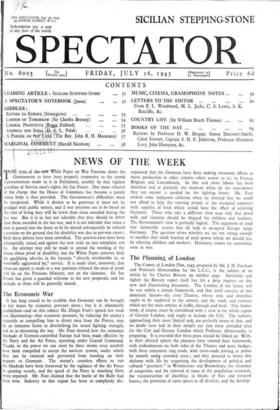The Planning of London
The County of London Plan, x943, prepared by Mr. J. H. Forshaw and Professor Abercrombie for- the L.C.C., is the subject of an article by Sir Charles Bressey on another page. Inevitably and rightly the Bressey report itself has left a deep impress on this new and illuminating document. The London of the future will be cast within a certain framework, and that itself consists of two dominant factors—the river Thames, whose uses and amenities ought to be exploited to the utmost, and the roads and railways which are the main arteries of traffic, through and local. This frame- work, of course, must be considered with a view to the whole region of Greater London, and ought to include the City. The authors, approaching their more limited task, are perfectly aware of that, and no doubt have had in their mind's eye that more extended plan for 'the City and Greater London which Professor Abercrombie is preparing. It is essential that these plans should be linked up. With- in their allotted sphere the planners have created their framework, with embankments on both sides of the Thames and more bridges, with three concentric ring roads, with cross-roads passing at points by tunnels undq crowded areas ; and they proceed to invest this skeleton with life by suggesting the development of political and cultural " precincts " in Westminster and Bloomsbury, the clearance of congestion and the removal of some of the population outwards, the reconstruction of dwellings in blocks of flats and terraced houses, the provision of open spaces in all districts, and the develop-
went of locality life and smaller neighbourhood units related to the elementary schools. The London depicted is not one that can emerge immediately, but the plan provides something definite and inspiring for the County Council and neighbouring authorities, and the Government, to get to work upon.



























 Previous page
Previous page